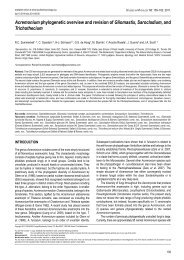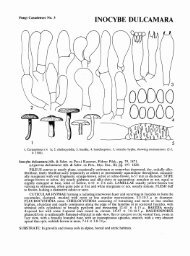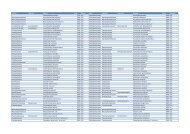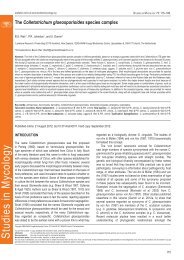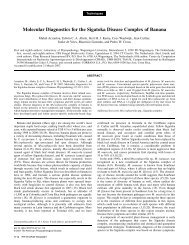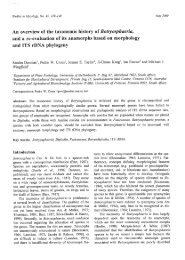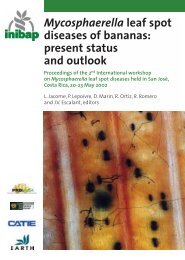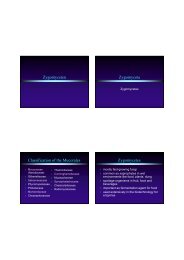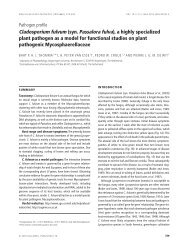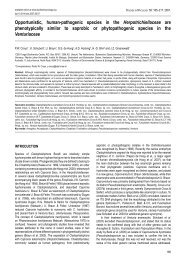Hypocrea rufa/Trichoderma viride: a reassessment, and ... - CBS
Hypocrea rufa/Trichoderma viride: a reassessment, and ... - CBS
Hypocrea rufa/Trichoderma viride: a reassessment, and ... - CBS
You also want an ePaper? Increase the reach of your titles
YUMPU automatically turns print PDFs into web optimized ePapers that Google loves.
Table 1. (Continued).<br />
HYPOCREA RUFA / TRICHODERMA VIRIDE<br />
Species Strain 1 Geography Substratum GenBank accession<br />
number<br />
ITS1 <strong>and</strong> 2 tef1<br />
H. neo<strong>rufa</strong> G.J.S. 96-141<br />
= ATCC MYA-2680<br />
U.S.A. (NJ) Acer, bark DQ846667 DQ846669<br />
H. neo<strong>rufa</strong> G.J.S. 96-132 U.S.A. (NJ) wood AF487653 AF487669<br />
H. neo<strong>rufa</strong> G.J.S. 96-135, T U.S.A. (NJ) bark AF487655 AF487670<br />
H. flaviconidia G.J.S. 99-49, T Costa Rica bark AY665696/<br />
AY665700<br />
AY665720<br />
T. paucisporum (An) G.J.S. 03-69<br />
= <strong>CBS</strong> 118978<br />
= ATCC MYA-3642<br />
Ecuador Theobroma cacao, rotting pod DQ109527 DQ109541<br />
T. paucisporum (An) G.J.S. 01-13<br />
= <strong>CBS</strong> 118645<br />
Ecuador Theobroma cacao, rotting pod DQ109526 DQ109540<br />
= ATCC MYA-3641,<br />
T<br />
T. theobromicola (An) DIS 85f, T Peru Theobroma cacao, stem<br />
endophyte<br />
DQ109525 DQ109539<br />
H. pezizoides G.J.S. 01-257 Thail<strong>and</strong> wood DQ000632 AY937438<br />
T. hamatum (An) DAOM 167057<br />
= <strong>CBS</strong> 102160,<br />
neotype<br />
Canada spruce forest soil Z48816 AY750893<br />
T. pubescens (An) DAOM 166162 U.S.A. (NC) forest soil DQ083027 AY937442<br />
T. asperellum (An) <strong>CBS</strong> 433.97, T U.S.A. (MD) sclerotia of Sclerotinia minor X93981 AY376058<br />
T. asperellum (An) G.J.S. 04-217 Peru Moniliophthora roreri on<br />
Theobroma cacao<br />
DQ381957 DQ381958<br />
1 Abbreviations of culture collections <strong>and</strong> collectors as follows: ATCC = American Type Culture Collection, Manassas, VA, U.S.A., BBA =<br />
Biologisches Bundesanstalt, Berlin, Germany; <strong>CBS</strong> = Centraalbureau voor Schimmelcultures, Utrecht, The Netherl<strong>and</strong>s; C.P.K. = Collection of<br />
C.P. Kubicek, Technische Universität, Abteilung für Mikrobielle Biochemie, Vienna; G.J.S., Tr = Culture collection of the United States Department<br />
of Agriculture, Systematic Botany <strong>and</strong> Mycology Lab, Beltsville, MD, U.S.A; DAOM = Canadian Collection of Fungal Cultures, Ottawa, Canada;<br />
DIS refers to CABI-Bioscience, Ascot, cultures held by G.J.S; ICMP = International Collection of Microorganisms from Plants, Manaaki Whenua<br />
L<strong>and</strong>care Research, Auckl<strong>and</strong>, New Zeal<strong>and</strong>; IMI = CABI-Bioscience, Egham, U.K.; J.B. = John Bissett, Agriculture <strong>and</strong> Agri-Food, Eastern<br />
Cereal <strong>and</strong> Oilseed Research Centre, Ottawa, Canada; W.J. = Culture collection of Walter Jaklitsch, Technische Universität, Abteilung für<br />
Mikrobielle Biochemie, Vienna; NR = Nippon Roche Corp. Tokyo, Japan<br />
2 From the culture collection of John Bissett, Agriculture <strong>and</strong> Agri-Food, Eastern Cereal <strong>and</strong> Oilseed Research Centre, Ottawa, Canada.<br />
3 An = isolation made from conidia or directly from substratum, all other cultures derived from ascospores.<br />
4 T = ex-type culture.<br />
Coilings, defined as circularly oriented <strong>and</strong> coiled<br />
intercalary or terminal parts of hyphae, were detected<br />
in the same way as autolytic excretions.<br />
Measurements were made from KOH or water<br />
mounts <strong>and</strong> we did not observe any differences when<br />
the respective reagents were used. Where possible,<br />
at least 30 units of each parameter were measured<br />
for each collection. Ninety-five percent confidence<br />
intervals of the means (CI) are provided; this figure<br />
represents the interval within which 95 % of the<br />
individuals of the parameter was found in the analysed<br />
isolates. The parameters used for analysis are listed in<br />
Table 2. Chlamydospores were measured by inverting<br />
a 7–15 d old CMD culture on the stage of a compound<br />
microscope <strong>and</strong> observing with a 40 × objective. Data<br />
were gathered using a Nikon DXM1200 or a Nikon<br />
Coolpix 4500 digital camera <strong>and</strong> Nikon ACT 1 software<br />
<strong>and</strong> measured either directly on the microscope or by<br />
using Scion Image (release Beta 4.0.2; Scioncorp,<br />
Frederick, MD).<br />
Five types of light microscopy were used, viz. stereo<br />
microscopy (stereo), bright field (BF), phase contrast<br />
(PC), Nomarski differential interference contrast (DIC),<br />
<strong>and</strong> epifluorescence (FL). The fluorescent brightener<br />
calcofluor (Sigma Fluorescent Brightener 28 C.I. 40622<br />
Calcofluor white M2R in 2 molar phosphate buffer at<br />
pH 8.0) was used for FL.<br />
Scanning electron microscopy (SEM) was done<br />
by one of two methods. Material for SEM studies was<br />
obtained from cultures that were grown on PDA for up<br />
to 2 weeks at 20–25 °C. Agar blocks with abundant<br />
conidia were prepared for SEM. For Figs 8 a–h all<br />
SEM procedures followed the protocols of Meyer &<br />
Plaskowitz (1989), <strong>and</strong> for Fig. 10h those of Carta et al.<br />
(2003) <strong>and</strong> Erbe et al. (2003).<br />
141




